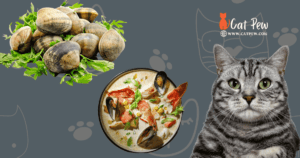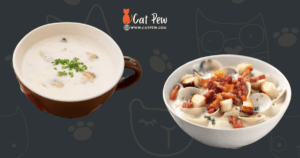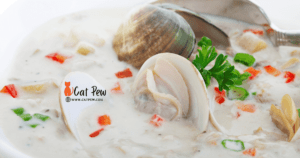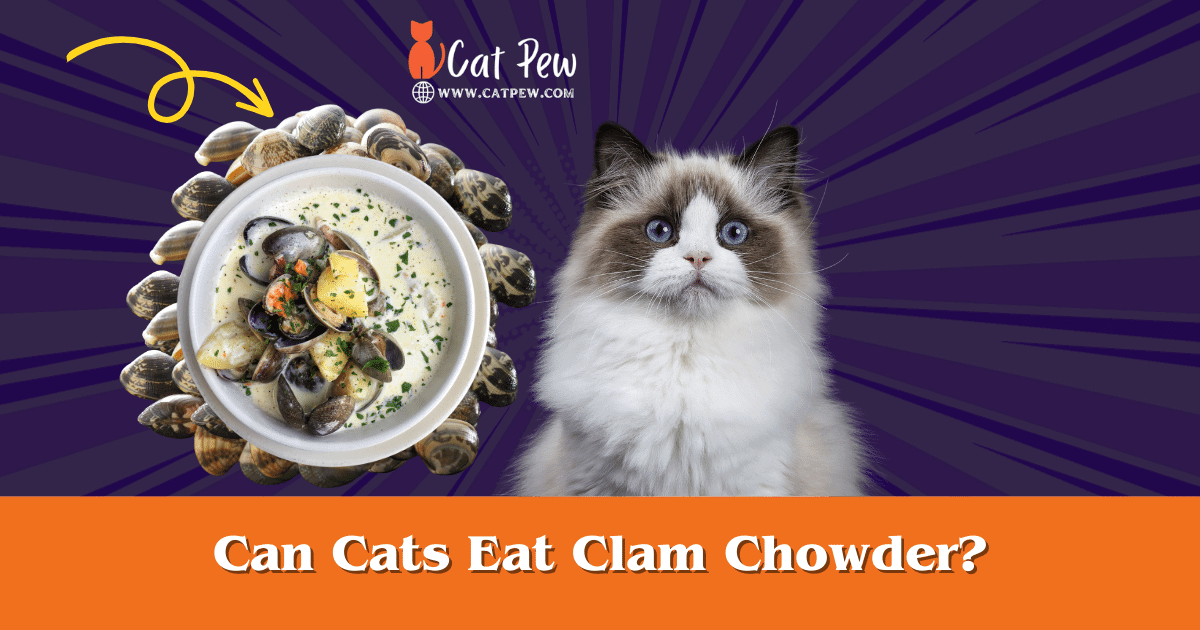No, cats should not eat clam chowder as it can be harmful to their digestive system. Introducing new foods to your cat’s diet requires careful consideration to ensure their health and well-being.
While clam chowder may be an enticing treat for you, it is important to remember that cats have specific dietary needs. Cats are obligate carnivores, which means their bodies are designed to primarily consume meat. Clam chowder is a human dish that contains ingredients, such as onions, garlic, and dairy, which can be harmful to cats.
Onions and garlic can cause anemia in cats, while dairy may lead to digestive issues. Therefore, it is best to avoid feeding clam chowder to your feline friend to prevent any potential health problems.
Clam Chowder: A Popular Seafood Dish

When it comes to seafood dishes, clam chowder is certainly a standout. This creamy, flavorful soup has been a beloved staple in American cuisine for centuries. Whether you’re a seafood lover or a fan of hearty soups, clam chowder offers a unique taste that is both comforting and satisfying. But can cats enjoy this delectable dish as well?
Origin And History Of Clam Chowder
Clam chowder has a rich history that dates back to the early days of American colonial settlements. It is believed to have originated in the coastal regions of the United States, where clams were plentiful and readily available. The exact origins of clam chowder are still debated, but it is commonly associated with New England cuisine.
The earliest versions of clam chowder were simple and rustic, made with ingredients that were readily available to early settlers. The soup typically consisted of clams, salt pork, onions, and potatoes, simmered together to create a hearty and nourishing dish.
Over the years, clam chowder has evolved and adapted to various regional preferences. Different cooking techniques, ingredients, and seasonings have been incorporated, resulting in the diverse range of clam chowder variations we know today.
Different Variations Of Clam Chowder
1. New England Clam Chowder:
New England clam chowder, often simply referred to as “clam chowder,” is perhaps the most famous and widely recognized variation. It features a creamy base made with milk or cream, tender clams, onions, potatoes, and sometimes bacon for added flavor. This version is known for its smooth and velvety texture, making it a comforting and indulgent choice.
2. Manhattan Clam Chowder:
Contrary to its New England counterpart, Manhattan clam chowder takes a tomato-based approach. This version swaps the cream for a tangy tomato broth, resulting in a lighter and more vibrant flavor profile. Alongside clams, it typically includes tomatoes, onions, carrots, celery, and a variety of herbs and spices.
3. Rhode Island Clam Chowder:
Similar to New England clam chowder, Rhode Island clam chowder also features a creamy base. However, it differs in its use of clear broth instead of milk or cream. This variation allows the flavor of the clams to shine through, offering a more delicate taste that is favored by many seafood enthusiasts.
| Variation | Base | Main Ingredients |
|---|---|---|
| New England Clam Chowder | Creamy | Clams, onions, potatoes, bacon |
| Manhattan Clam Chowder | Tomato-based | Clams, tomatoes, onions, carrots, celery, herbs |
| Rhode Island Clam Chowder | Clear broth | Clams, onions, potatoes |
These are just a few examples of the many regional variations of clam chowder. Each variation brings its own unique twist to this beloved seafood dish, offering seafood enthusiasts a range of choices to suit their individual tastes.
While clam chowder is undoubtedly a delicious and popular dish among humans, it is important to note that cats have different nutritional needs and digestive systems. As such, it is not recommended to feed clam chowder or any other human food to cats without consulting with a veterinarian first. Your feline friend’s health and well-being should always be the top priority.
Understanding A Cat’s Dietary Needs

As pet owners, it is our responsibility to provide our feline friends with a proper and balanced diet. Understanding a cat’s dietary needs is crucial for their overall health and well-being. While cats are known to be carnivores, it’s essential to comprehend their basic nutritional requirements and the key components of a healthy cat diet.
Basic Nutritional Requirements Of Cats
Cats have unique dietary needs that differ from other animals. They are obligate carnivores, meaning they require a high-protein diet primarily sourced from animal tissues. Along with protein, there are other crucial nutrients that should be included in their diet:
- Water: Cats have a low thirst drive, so it’s vital to ensure they have access to fresh water at all times. Proper hydration is essential for their renal, digestive, and overall health.
- Protein: Cats need a diet high in quality animal protein to fulfill their biological requirements. Protein provides essential amino acids needed for the growth, maintenance, and repair of body tissues.
- Fat: Including a moderate amount of healthy fats in a cat’s diet is important for energy and the absorption of fat-soluble vitamins. It also helps maintain healthy skin and a glossy coat.
- Carbohydrates: Unlike humans, cats have a limited ability to digest carbohydrates. While it’s not mandatory to include carbohydrates in their diet, a small amount from easily digestible sources can provide energy.
- Vitamins and Minerals: Cats require various vitamins and minerals, including vitamin A, vitamin D, vitamin E, calcium, phosphorus, and taurine. These nutrients support their immune system, bone health, and overall well-being.
Key Components Of A Healthy Cat Diet
To ensure your cat’s diet promotes optimal health, it’s important to focus on the following key components:
- High-Quality Protein: As obligate carnivores, cats need a diet rich in high-quality animal protein. It can be provided through meat, poultry, fish, and eggs. Avoid processed and low-quality meat by-products that may lack essential nutrients.
- Balanced Fat Content: While fats should be included in a cat’s diet, it’s crucial to maintain a balance. Excessive fat consumption can lead to obesity and other associated health issues. Opt for lean cuts of meat and avoid greasy or fried foods.
- Essential Fatty Acids: Omega-3 and omega-6 fatty acids are vital for your cat’s skin, coat, and joint health. These can be obtained from fish oil supplements or through including oily fish like salmon in their diet.
- Taurine: Taurine is an essential amino acid for cats that plays a vital role in maintaining cardiac health, reproductive health, and preventing certain eye diseases. Ensure their diet contains adequate taurine levels, usually found naturally in animal tissue.
- Controlled Carbohydrates: Cats don’t need a significant amount of carbohydrates in their diet, so it’s essential to limit their intake. Choose sources like whole grains and legumes, but ensure they are easily digestible.
By understanding a cat’s basic nutritional requirements and focusing on providing a diet rich in high-quality protein, balanced fats, essential fatty acids, taurine, and controlled carbohydrates, you can ensure your feline companion maintains optimal health and vitality.
Can Cats Safely Consume Clam Chowder?

Clam chowder is not recommended for cats as it can be harmful to their digestive system. Cats have different dietary requirements and should stick to their own specialized cat food. It’s best to avoid feeding them any human food without consulting a veterinarian first.
Potential Health Risks Of Feeding Clam Chowder To Cats
While clam chowder may be a delicious treat for humans, it is important to consider whether it is safe for cats to consume. Cats have specific dietary needs that may not align with the ingredients found in clam chowder. Before sharing a spoonful with your furry friend, it’s crucial to be aware of the potential health risks involved.
Milk-based broth: Clam chowder typically contains milk or cream as a base. While kittens may have a higher tolerance for lactose, most adult cats are lactose intolerant. Feeding them milk-based products like clam chowder can lead to digestive upset, including vomiting and diarrhea.
Onions and garlic: Many clam chowder recipes include ingredients like onions and garlic for flavor. These ingredients belong to the allium family and are toxic to cats. Consumption of even small amounts can lead to anemia and damage to the red blood cells in cats.
Seasonings and additives: Commercially prepared clam chowder often contains additional seasonings and additives that may not be suitable for feline consumption. Ingredients like salt, pepper, and other spices can be harmful to cats in large quantities. Moreover, additives like MSG and artificial flavors can cause adverse reactions in some cats.
Seafood allergies: Some cats may have allergies or sensitivities to seafood. Clam chowder contains clams, and while they are not commonly allergenic for cats, there is still a possibility of an allergic reaction. Symptoms may include itchy skin, swelling, diarrhea, vomiting, or difficulty breathing. If your cat has never been exposed to seafood before, it is recommended to introduce it in small amounts and monitor for any signs of allergies.
The Importance Of Consulting A Veterinarian
Before introducing any new food into your cat’s diet, it is essential to consult with a veterinarian. They can provide professional advice tailored to your cat’s individual needs and health requirements. A veterinarian can assess whether clam chowder or any specific ingredient poses a potential risk to your cat’s health.
A veterinarian consultation is particularly crucial if your cat has a pre-existing health condition, such as kidney disease or allergies. These conditions may require a strict dietary regimen, and introducing clam chowder without guidance could have adverse effects.
Remember, while it might be tempting to share your clam chowder with your feline companion, their well-being should always come first. By consulting with a veterinarian and being aware of potential risks, you can ensure your cat’s safety and provide them with a healthy, balanced diet.
Alternatives To Clam Chowder For Cats

While clam chowder may be a delightful seafood dish for us humans, it is important to remember that cats have different dietary needs. While some cats may enjoy a taste of clam chowder, it is not recommended to feed it to them regularly due to the high levels of sodium and seasonings that can be harmful to their health. However, there are plenty of alternatives to clam chowder that you can consider to give your feline friend a safe and enjoyable seafood experience.
Cat-friendly Seafood Options
When it comes to feeding your cat seafood, it is important to select options that are safe and healthy for them. Here are some cat-friendly seafood options that you can consider:
- Tuna: Tuna is a popular seafood choice for cats. It is rich in protein and omega-3 fatty acids, which can promote a healthy coat and skin.
- Salmon: Salmon is another seafood option that many cats enjoy. Just like tuna, it is a good source of protein and omega-3 fatty acids.
- Shrimp: Shrimp can be a tasty treat for cats. It is low in calories and provides a good amount of protein.
- Whitefish: Whitefish, such as cod or haddock, can be a good seafood option for cats. It is low in fat and provides essential nutrients.
Homemade Cat Food Recipes Using Safe Ingredients
If you prefer to prepare your cat’s meals at home, there are homemade cat food recipes that you can try using safe ingredients. Here are a few ideas:
- Chicken and fish stew: Combine cooked chicken and whitefish with a small amount of water or chicken broth. Cook it gently until the meat is tender and the flavors blend together.
- Tuna and rice bowl: Cook some brown rice and mix it with canned tuna in water. This simple recipe provides a balance of protein and carbohydrates.
- Salmon and pumpkin mash: Steam some salmon and mash it together with cooked pumpkin. This recipe is rich in omega-3 fatty acids and fiber from the pumpkin.
Remember, when preparing homemade cat food, it is important to consult with your veterinarian to ensure that your cat’s nutritional needs are being met.
Tips For Introducing New Foods To Cats

Discover tips to help introduce new foods to cats, including clam chowder, and ensure a successful transition without any negative impacts on their health and well-being.
Gradual Introduction Of New Foods
When it comes to introducing new foods to your feline friend, it’s important to take things slow. Cats can be quite particular when it comes to their diets, so a gradual approach is key to ensure they can adjust comfortably.
Start by offering small amounts of the new food alongside their regular diet. This allows your cat to become familiar with the new taste and texture without overwhelming their taste buds. Keep in mind that abrupt changes in their diet may lead to digestive upset and refusal to eat the new food.
A gentle transition should be done over the course of several days. Begin by substituting a small portion of their regular food with the new food. As your cat becomes more accustomed to the new food, gradually increase the proportion until they are fully transitioned.
Monitoring Your Cat’s Response To New Foods
It’s crucial to closely monitor your cat’s response to new foods during the transition period. Each cat is unique, and their tolerance for different ingredients may vary. Keep an eye out for any adverse reactions, such as vomiting, diarrhea, or changes in behavior.
Additionally, take note of any allergic reactions that may occur. Cats can develop allergies to certain ingredients, so be vigilant for signs of itchy skin, excessive grooming, or respiratory issues. If any concerning symptoms arise, it’s best to consult with your veterinarian to determine the underlying cause and find a suitable alternative.
In some cases, a cat may simply be a picky eater and might refuse to eat the new food altogether. If this happens, don’t force the issue. Cats have their preferences, and it’s essential to respect their individual tastes. You can try introducing different flavors or textures to find something that suits their palate.
Frequently Asked Questions On Can Cats Eat Clam Chowder
Can Cats Eat Clam Chowder?
No, cats should not eat clam chowder. Clam chowder contains ingredients such as cream, onions, and spices that are not suitable for cats. These ingredients can upset their digestion and potentially cause health issues. It’s best to stick to a balanced and appropriate diet for your feline friend.
What Ingredients Are Present In Clam Chowder?
Clam chowder typically contains clams, potatoes, onions, celery, cream, butter, and various spices. These ingredients combine to give the chowder its savory and creamy taste. However, it’s important to note that these ingredients are not suitable for cats, as they have different dietary needs.
Are Clams Safe For Cats To Eat?
Clams are generally safe for cats to eat in small quantities. However, it’s important to ensure that the clams are properly cooked, without any seasonings or added ingredients. Offering small, cooked pieces of clam as an occasional treat can be a good source of protein for your feline friend.
However, it’s always best to consult with your veterinarian before introducing new foods into your cat’s diet.
Conclusion
Cats should not be given clam chowder as it contains ingredients that are potentially harmful to them. It is essential to prioritize their health and stick to a well-balanced diet specifically designed for their nutritional needs. Always consult with a veterinarian to ensure you are providing the best food options for your feline friend.
Remember, their well-being is our responsibility.

Winston
I'm Winston, the author of this feline-focused (Catpew.com) blog . My love for cats goes back to my childhood, when I spent countless hours playing with my family's tabby, Mittens. This furry friend instilled in me a deep appreciation for the unique personalities, playful nature, and unconditional love that cats offer.

